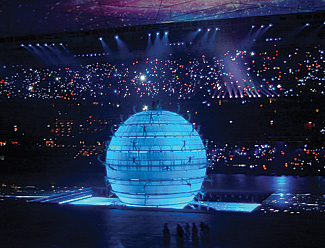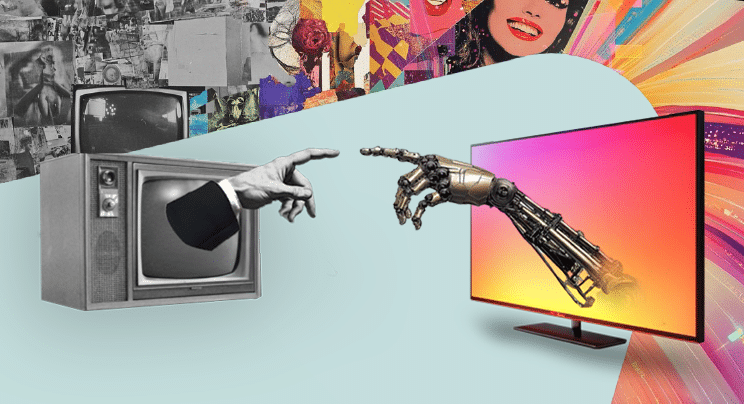Ceremony Lighting Wows World Audiences
BEIJING
I love Olympic opening ceremonies. Only a proud nation, anxious to shine before an audience of billions around the world, will throw so many resources at an entertainment spectacular on such a grand scale. Since the opening of the 2000 Summer Olympics in Sydney was staged as a vast theatrical production, each of the succeeding ceremonies has raised the bar for spectacle, inventiveness and investment of resources.
The Sydney show was initially conceived as stage production: a musical theater show on a grand scale, performed on a sports field for the 90,000 people sitting in the arena. However, as the production wasn't explicitly developed with television coverage in mind, it fell to the television director, who fortunately was a master of live-to-air entertainment events, to independently develop the coverage of this "stage" show for the billions in the broadcast audience.
In Athens in 2004, the world television audience was clearly uppermost in the minds of the ceremony producers, as much of the detail in the scenery and costumes was totally invisible to the audience in the arena. Indeed, many of the clever pieces of design and illusion worked only from a small number of designated camera angles. The arena itself was built to include a complex flying rig, a system of embedded stage lifts, and in a country renowned for its dubious plumbing, an astounding water supply system that allowed a lake to fill and drain before our very eyes.

The Olympics relied on thousands of light imported into China. What we saw in Beijing on 08/08/08 was a spectacle designed at every level for the broadcast camera, yet one that also worked very effectively for the stadium audience. We witnessed the twenty-first century rebirth of the kaleidoscopic massed choreography made popular in 1930s movies by the legendary choreographer and director Busby Berkeley. Whilst Berkeley was limited by budgets in the number of performers and the extensive rehearsal times required to set and perfect his epic creations, there were clearly no such limits on the production of the Beijing ceremonies. The levels of coordination attained in every segment of the ceremonies were nothing short of jaw-dropping.
Like everyone else in the world, I was thoroughly impressed by the precise coordination of those 2008 drummers in the very first sequence, and like everyone else in the production business, I was busy speculating on what type of wireless system was being used to control the LED panels in the drums and the LEDs in the drumsticks.
On learning that the wireless control system was simply 2008 incredibly well-rehearsed drummers, each independently operating the switches on their equipment, it began to dawn me just how much of a commitment the Peoples Liberation Army had made to astounding the world with these ceremonies. The lunch budget alone for the daily rehearsals over the months that the ceremonies were put together and refined would have easily surpassed the entire production budget for the Sydney ceremony in 2000 and was probably greater than the lighting budget for Beijing.
LIGHT YEARS
The show lighting was a surprise in many ways. For a start, it was almost entirely robotic and there was plenty of it. While in 2008 that may not seem particularly surprising, if you cast your mind back to the Sydney and Athens ceremonies you may recall that Sydney was struggling for levels with the world's entire inventory of HES Cyberlights with Turbo optics (just 300 of them). These were supplemented by most of Europe's OB rental stock of 4 kW HMI PARs and the majority of the world's 7 kW Xenon color-changing searchlights perched on the edges of the grandstands for use as supplementary arena side lighting. By 2004 there were many more bright robotic luminaries available for use in Athens, but even so, to get the necessary levels, there were a significant number of them on the edges of the arena to supplement the overhead rig. You may also recall that there was very little use of deep saturated color in either Sydney or Athens as there simply wasn't the light available to throw away in filters. Beijing's more than 1,500 full color-mixing wash lights provided lighting designer Sha Xiao Lan with enough light for respectable levels across the very broad pallet he used in the ceremonies.
IMPORTS TO CHINA
More remarkable than the levels achieved was the choice of instruments for the rig. The majority of the luminaries came from European companies with only a relative handful of fixtures from Chinese manufacturers. While this may have to do with the fact that yet again, German über-rental company Procon was the principal equipment supplier to an Olympic games, it speaks volumes for the technical conservatism of the production team. Although southern China may be producing an unstoppable deluge of budget-price moving lights that are overwhelming the markets throughout the world, even in their own country they are not yet perceived as the fixtures that they are prepared to bet their shows on. That said, I'm prepared to predict that the majority of fixtures used for the London ceremonies in 2012 will have been built in China.
From a lighting control perspective the Beijing setup was almost anticlimactic in its simplicity. The first robotic Olympics ceremonies in 2000 required 16 Flying Pig WholeHog IIs (seven systems plus their live tracking backups, plus two spares) and two Strand 500is (main and tracking backup) to control a mere 970 robotic fixtures and 658 conventional luminaries. The 43,000 parameters required to control the 2,500 robotic fixtures for Beijing were handled by a pair of full-size grandMA consoles running in multisession mode. These grandMAs drove some 46 Network Signal Processing nodes, which give the system a raw capacity of 184 DMX universes.
Perhaps the most dramatic change in the visual presentation for the Beijing ceremonies was the amount of video integrated into so many aspects of the production. While Sydney may have been the first robotic Olympics ceremony, there is little doubt that a system of over 60 media servers feeding more than 140 high-power high-definition projectors, many with robotically controlled optics, marks the Beijing ceremonies as a turning point in the use of video as a major visual design element for these spectacles.
If nothing else it may have helped us by making the sports enthusiasts in our boardrooms aware that the incorporation of video into our own productions is both visual enriching and inevitable.
The professional video industry's #1 source for news, trends and product and tech information. Sign up below.
